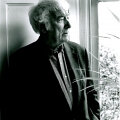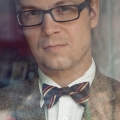
Ogniska w święto Beltane
Przełożył Jacek Dehnel
Beacons at Bealtaine

Seamus Heaney, urodził się w 1939 roku, zmarł w 2013 roku, był jednym z najlepszych i najpopularniejszych irlandzkich poetów. W swojej twórczości czerpał inspirację zarówno ze swojej osobistej historii, jak i z przeszłości i teraźniejszości Irlandii. W wierszach Heaneya widoczna jest jego umiejętność oczarowywania czytelnika nawet poprzez opis tego, co z pozoru zwyczajne. Za „dzieła o lirycznej piękności i etycznej głębi, które chwalą cuda dnia codziennego i żywą przeszłość” została mu przyznana w 1995 roku literacka nagroda Nobla. Wiersz Ogniska w święto Beltane został napisany przez Seamusa Heaneya z okazji przyjęcia dziesięciu nowych państw, w tym Polski, do Unii Europejskiej podczas irlandzkiej prezydencji. Heaney przeczytał ten wiersz podczas uroczystości rozszerzenia Unii, która miała miejsce w dublińskim Parku Feniksa 1 maja 2004, tłumacząc że: „W kalendarzu celtyckim, który kiedyś wyznaczał pory roku w wielu częściach Europy, pierwszego maja przypadało święto nazwane po irlandzku Bealtaine – festiwal jasnego ognia, pierwszy dzień wiosny i data wyznaczająca początek jednego z kwartałów. Wczesnoirlandzka Leabhar Gabhála („Księga Przejęcia Irlandii”) opowiada o pierwszych mieszkańcach Irlandii, magicznych Tuatha Dé Danaan, którzy przybyli na wyspę właśnie w dniu święta Bealtaine, a tekst pochodzący z IX wieku wskazuje, że tego dnia druidzi zapędzali swoje stada, by te pasły się pomiędzy dwoma ogniskami. Jest więc jakaś pomyślna wróżba w tym, że to spotkanie Europejskich narodów odbywa się właśnie w dniu, w którym na Irlandię przybyli pierwsi osadnicy. Jeszcze większą nadzieję budzi fakt, że świętujemy to spotkanie w parku nazwanym na cześć tego mitycznego ptaka, który symbolizuje nieograniczoną możliwość powtórnych narodzin. Ale są także ludzie, którzy twierdzą że nazwa Park Feniksa pochodzi od irlandzkich słów fionn uisce¸ które oznaczają czystą wodę. To właśnie ta wieloznaczność zainspirowała mnie do napisania tego wiersza. Możliwe, że Horacy uznałby go za carmen sæculare, wiersz napisany by uczcić historyczny przełom sæculum – epok.”
Seamus Heaney (1939-2013), was one of Ireland’s most celebrated poets. His works draw inspiration from his personal history, as well as the past and present of Ireland. He was awarded the Nobel Prize in Literature in 1995 “for works of lyrical beauty and ethical depth, which exalt everyday miracles and the living past.” ‘Beacons at Bealtaine’ was written by Seamus Heaney to mark the accession of ten new countries, including Poland, to the European Union on 1 May 2004 during Ireland’s EU Presidency. Heaney himself recited the poem at the Enlargement Ceremony that took place in Dublin’s Phoenix Park. He explained: ‘In the Celtic calendar that once regulated the seasons in many parts of Europe, May Day, known in Irish as Bealtaine, was the feast of bright fire, the first of summer, one of the four great quarter days of the year. The early Irish Leabhar Gabhála (The Book of Invasions), tells us that the first magical inhabitants of the country, the Tuatha Dé Danaan, arrived on the feast of Bealtaine, and a ninth century text indicates that on the same day the druids drove flocks out to pasture between two bonfires. So there is something auspicious about the fact that a new flocking together of the old European nations happens on this day of mythic arrival in Ireland; and it is even more auspicious that we celebrate it in a park named after the mythic bird that represents the possibility of ongoing renewal. But there are those who say that the name Phoenix Park is derived from the Irish words, fionn uisce, meaning "clear water" and that coincidence of language gave me the idea for this poem. It's what the poet Horace might have called a carmen sæculare, a poem to salute and celebrate an historic turn in the sæculum, the age.’

Jacek Dehnel, urodził się w 1980 roku w Gdańsku, prozaik, poeta, tłumacz, malarz. Mieszka w Warszawie.
Jacek Dehnel, born in 1980 in Gdańsk, prose writer, poet, translator, painter. He lives in Warsaw.

